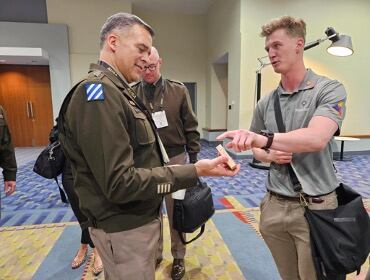Thousands of people each year find themselves in need of a life-saving procedure involving bone marrow from a donor.
One soldier at Fort Bliss, Texas, saw the need for donors and took matters into his own hands. Now, Spc. Christian Sutton is known as “Bone Marrow Guy.”
He got the inspiration while attending a concert.
“I saw a table registering people who are going to the National Bone Marrow Registry,” Sutton told Military Times. “I really liked the idea. If it was simple enough to register drunk people in a mosh pit it was probably easy enough to do in the Army.”
Sometimes, a patient will find a bone marrow donor in a family member — it’s paramount that they find someone who is a tissue match. However, in 70% of cases, that’s not possible, and the patient needs to seek out another donor.
Currently, over 9 million potential donors have volunteered with the National Bone Marrow Registry, according to the Health Resources & Services Administration. But those numbers still don’t guarantee a match, especially for patients of various ethnicities or races. HRSA data shows that only 3.9 of the 9 million registered represent American Indians or Alaska Natives, Asians, Black or African Americans, Hispanic or Latinx, and Native Hawaiian or Pacific Islanders.
“Some ethnic groups have more complex tissue types than others,” notes Be the Match, a registry of donors operated by the National Marrow Donor Program. “So a person’s best chance of finding a donor may be with someone of the same ethnic background.”

To date, Sutton has registered 3,982 people personally. And Sutton’s Army-based team has registered more than 5,000 soldiers. He cobbled this group of soldiers together after initially reaching out through the Department of Defense Marrow Donor Program — known as Salute to Life. But there is some bureaucracy involved that Sutton is hoping to alleviate. His goal now is to streamline the process for troops who want to donate bone marrow.
He calls it “Operation Ring The Bell.” It’s a soldier-led volunteer initiative that helps organize bone marrow registry drives at Army bases across the country.
“Our goal is to create literally every resource, dataset, and proof of concept to give the Army the tools to seize its potential to instantly become the largest source of donors in the U.S.,” Sutton wrote on Reddit.
Donation is anonymous, and because of the way the process works, the recipients typically don’t get to meet their donors.
“Donors usually don’t meet or find out much about their recipient, unless the recipient consents to that ... unless they want to meet you,” Sutton said.
Even with the anonymity of the process, serving beyond military service is what fuels Sutton.
“It was pretty eye-opening to be able to find a way of serving that both fit within what I found important, as well as finding that much support from the leaders that I’ve met while doing this,” he said. “So I think I think it fits within what the Army does. It’s just a different avenue of service and different idea of service, but it’s all service.”
Sarah Sicard is a Senior Editor with Military Times. She previously served as the Digitial Editor of Military Times and the Army Times Editor. Other work can be found at National Defense Magazine, Task & Purpose, and Defense News.





